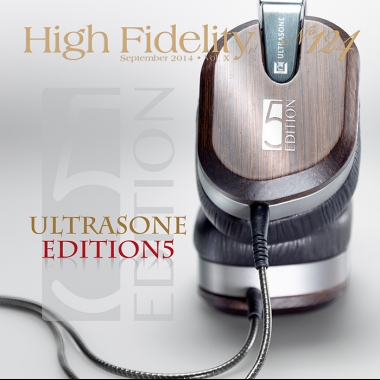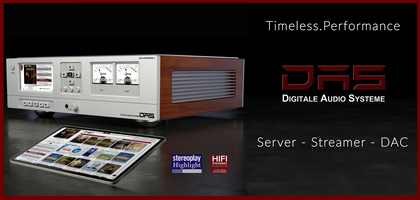No. 248 January 2025
- COVER REVIEW: Gigawatt POWERMASTER 25 ANNIVERSARY EDITION ⸜ AC power conditioner » POLAND
- KRAKOW SONIC SOCIETY № 149: High Fidelity Presents: ART FARMER: Art Farmer in Wrocław » POLAND/Krakow
- REVIEW: Audio Phonique DESIRE SP ⸜ speaker cables » POLAND
- REVIEW: Avatar Audio DREAMLINK № 1 ⸜ analog interconnect • RCA » POLAND
- REVIEW: DS Audio MASTER 3 ⸜ optical cartridge + phono stage » JAPAN
- REVIEW: Laiv HP2A ⸜ preamplifier/headphone amplifier » SINGAPORE
- REVIEW: TiGLON TPL-2000L Professional ⸜ LAN cable » JAPAN


|

|
|
THE AUDIOPHILE IN THE READING ROOM

Experts came up with different diagnoses. The common factor between them was noticing the deep-running change in reading habits, connected to the dominance of the Internet. As experts say, the layout of text on webpages and the very short form they are presented in, as well as the growing popularity of short text messages and Twitter messages have changed our reading habits. Few people are able to focus on longer text. This tendency is only going to get worse. I have nothing against the Internet, even though I am often drowning under piles of real paper books and magazines, since I was born and raised in a time when they had more value. But without the Internet I wouldn’t have been able to found and run “High Fidelity”. The Web turned the publishing market into more of a democracy and created an opening for people with different opinions. This level of freedom won’t ever be taken away from us… unless the power goes out. The Internet also gives the unique advantage of search functions, dramatically easing access to information. But even some of the advantages have become problems. Search engines, with Google.com being the leader of them all, present information in a specific way, a way that prefers the promoted and advertised results. The Internet is ruled by money, not by the weight of supplied information. And although this isn’t a problem to all people, the surplus of information should concern everyone. 
I don’t intend to turn the tide and encourage people to leave the internet and torture themselves with long texts like my article about the new re-master of Czesław Niemen’s Dziwny jest ten świat… (recently also published by “Positive-Feedback Online” magazine; you can found it HERE), or my interview with John Marks. It wouldn’t be bad if this worked out. But I try to be a realist and I know it’s just not going to happen. But still, opposing my better judgement somewhat, I also write and publish articles like that. That must mean I see a point in doing so, right? That’s why it’s worth at least trying to read through a longer piece of text about something that we’re interested in. It really is worth collecting not only albums, but also books that relate to them, and music in general. Especially since there have recently been many extremely interesting and well-published releases relating to music and audio. I’d like to tell you a little bit more about some of the newest and most interesting ones.  The Absolute Sound’s Illustrated History of High-End Audio. Volume One: Loudspeakers red. ROBERT HARLEY, Nextscreen, Austin 2014 
This prestigious release has been announced on the website of “The Absolute Sound” as well as the magazine itself, since 2013. The gradually-released pdf fragments, as well as content descriptions, created a sense of anticipation for something very special. Robert Harley who plays the role of the volume’s editor, told me back then that the amount of work that went into preparing this release was huge and he had never prepared himself for it. He had undertaken the job of preparing a book which would become the model material about the most interesting, most famous and most important loudspeakers in the audio world, as well as their makers. The first tome is dedicated to that particular part of our little world: the subsequent volumes will be about amplifiers (volume two) and sound sources (volume three). The company presented the release’s content as follows:

As soon as Robert told me about it, I pre-ordered the book, paid and waited patiently for its release. And nothing happened – I never got it, even though the TAS editor-in-chief assured me that it’s already on the market. After a few interventions it turned out that my parcel was lost somewhere along the way. And yes, instead of one of the earliest numbers I received one of the last ones: 2362. Only the first 2500 copies were hand-numbered. 
The volume’s editing work was done by the chief editor of TAS. The authors of specific stories, parts and descriptions are journalists and co-workers from the magazine. They are: Jonathan Valin, Steven Stone, Paul Seydor, Dick Olsher, Alan Taffel, Alan Sircom, Jim Hannon, Chris Martens, Wayne Garcia, Kirk Midtskog, Robert E. Greene and Jacob Heilburn. The point was for the particular companies, designs and technologies to be described by people who had most contact with them, people who used these products in their systems, people who have met their designers – in other words, people to whom this stuff actually MATTERS. 
This isn’t a read for one evening, nor for one week, or even a single month. I see it more as a kind of “bible”. Of course there are things that could be improved, added or explained (every release of this kind is an open project of sorts), but so far I haven’t really found anything that needs improvement. The photos are excellent, the articles are well-written and packed with facts I didn’t know about. Ken Kessler has already paved the way with his monographs on the history QUAD, McIntosh and KEF (more to come) and now TAS really dots the i’s and crosses the t’s with this project. You just can’t not have this. And besides, the Illustrated history… provokes you to do something even better: to hunt the autographs of the people it talks about. Robert Harley signed it at the stand of the German “LP” magazine during the High End 2014 show in Munich – unfortunately, I wasn’t able to catch him. What I did manage to do, however, was to catch a few of the several dozen of audio icons I read about in the book – people who were kind enough to sign the appropriate articles in it.  Dust&Grooves. Adventures in Record Collecting red. EILON PAZ, Dust&Grooves, Nowy Jork 2014 
I don’t think we need to convince anyone about the fact that we love gadgets and gizmos. Although we loudly proclaim our love for music, we assure people that it’s all about the content and not about the way it’s delivered (hardware), we’re really lying to ourselves. In the perfectionistic world of audio both of these elements are equally important. And that’s that. We love both the music and the technology that we use for its playback. Eilon Paz is a photographer. As he says, he got interested in people who like collecting things due to loneliness. In 2008 he left Israel, his homeland, and moved to New York. He fell upon dire times: the recession made it difficult for him to find a job. At the same time, on the audio market, the vinyl branch of music began stirring back to life, and almost every store got a designated section with black discs only – people began writing about them and it became a trendy topic. The trigger that released Paz’s incredible imagination was a photo of a man in combat boots, holding an AK-47, surrounded by an amazing number of records. The man on the photograph turned out to be a German, Frank Gossner, who regularly travelled to West Africa in search of vinyls. It was incredible in the sense that he lived very close to Paz, in Brooklyn. And that’s how the story begins. 
Eilon Paz’s project was all about meeting collectors and taking photos of them and their albums. His photos and the stories behind them were published on the website “Dust & Grooves”. The next step was moving the project from the virtual world into the real world, in the form of a book. Although he had a good idea, he lacked the funds to bring it to life. It would require him to travel the world, after all. And thus he began collecting money using the online fundraising system, Kickstarter. He quickly gathered the required amount of money and got right down to work. The book was released at the perfect moment, on Record Store Day, April 14th 2014 (in the USA, it was available in Europe a month later; read more about the event in Kraków HERE).    MAREK KAREWICZ, MARCIN JACOBSON Big Beat, Sine Qua Non, Kraków 2014 
|
It so happens that the release of this book coincided with “High Fidelity” publishing an article about Czesław Niemen, part of our 10-year anniversary celebrations. This allowed me to use a fresh quote that begins the story of “Dziwny jest ten świat”. When describing his first meeting with the author of Sukces, Marek Karewicz doesn’t hide the fact that the photos he took of people connected to Polish pop music and the Poland-specific “Big Beat” movement were only done for money. His first and biggest love was jazz music. That’s why the most valuable book to him is This is Jazz, with his photos of some of jazz biggest stars, from Miles Davis to Ella Fitzgerald. And yet it’s him, one of Poland’s most important photographers, who took pictures which became the album covers for artists like Breakout Blues, Ewa Demarczyk and her renditions of Zygmunt Konieczny’s songs, Czerwono-Czarni, Niebiesko-Czarni, Polanie, Czerwone Gitary, Niemen, Grechuta, No To Co, Skaldowie, Nalepa, Blackout, Halina Frąckowiak, SBB and many others. He has made over 1500 covers and has taken thousands of famous photos. The most iconic one remains the aforementioned Blues cover, where Tadeusz Nalepa, the frontman of Breakout, leads his little son Piotr by the hand. Every Polish music lover knows it. 
Karewicz was an extremely cunning man who knew how to stand his ground. He shares the secret of how it was possible for him to create so many album covers in the introduction to his book, where he wrote: To be honest, it was the Polskie Nagrania record label that really set me up on the market. In total, I designed over 400 covers for them. Since I knew how to process pictures, photography was my chosen medium. 
Big Beat is a collection of Karewicz’s memories, written down by his friend, Marcin Jacobson. Karewicz only wrote the foreword, although his last name is still on the cover. The book is composed of memories regarding specific album covers, all kept in the spirit of “those days”, i.e. the 1960-1980 time period. The book is very nicely released, in the form of a 10” record, square in shape, with lots of brilliant photos and – obviously – album cover copies. And it’s the latter that I have concerns about: I think that larger, full-page album cover reproductions were what was really missing from this release. The miniatures I saw didn’t do justice to the original projects in the slightest. The book’s cover is made with a fancy technique, with an embossed, varnished title.  MAREK A. KAREWICZ, DIONIZY PIĄTKOWSKI Czas Komedy, Oficyna Wydawnicza G&P, Poznań 2013 
A year prior, a different book with Marek Karewicz’s last name on the cover was published – a book he prepared with Dionizy Piątkowski, a music journalist and critic, a jazz promoter, and the man behind the idea for the Polish festival called Era Jazzu. Piątkowski is the author of the Encyclopedia of popular music – JAZZ from 1999.    MILES DAVIS & QUINCY TROUPE Miles. Autobiografia Tłum. Filip Łobodziński, Wydawnictwo Dolnośląskie, Wrocław 2013 
It’s a wonder that this book saw a proper release only last year. It was published in the USA in 1989, two years before the artist behind Kind of Blue passed away, and its first Polish edition appeared in 1993, titled Ja, Miles (I, Miles). In 2006, the Constanti Jerzy Szczerbakow publishing house published the second edition, translated by Filip Łobodziński.
Written down by Quincy Troupe, the memories of Miles Davis, a jazz legend, are a combination of the childhood, youth and adulthood of a trumpet player who will always be mentioned as one of the most important jazz musicians to ever play this instrument. But the memories are remarkable! Davis doesn’t drape his words in a veil of seriousness, he doesn’t strive for some “high style”, but he uses his everyday language – cursing where necessary, falling into deep thought at times, and always remaining extremely honest. The description of his addiction and the way he dealt with it reminds me of what Tomasz Stańko wrote in his autobiography, Desperado. Only after I read this book did I seriously sit down and start listening to his later albums, the ones that are less respected than his early work, i.e. the bebop, modal and fusion years (electric fusion with another “great” quintet). This man was a pioneer who paved the path for musicians after him, and yet he explains why he so often changed the musicians he cooperated with – why he was so picky while choosing them and then so ruthless when firing them. And I believe everything he said.   Another perspective Choices by: BARTOSZ PACUŁA 
When I was asked to choose the best books about music, I got a little grim. The times we live in have an almost absurd abundance of books of this kind, and before we even make it past the half-mark of a band’s biography, we are already being encouraged to buy another book about the same band, but a “bigger, better and truer/authorized/one-and-only” edition. I decided to handle this challenging mission as follows: I would like to recommend three books to those “High Fidelity” readers who have an interest in the given field and want to enrich their musical knowledge – these three books are the gems of their genres. One of them will be a classic biography, a book that follows the story of a band from the moment of their members’ births to the most recent of times; an autobiography, meaning the memories of a musician; and an extended interview, in which the story of a musician/artist is shown through a conversation with them. BiographyMARK BLAKE Prędzej świnie zaczną latać Wydawnictwo Sine Qua Non 
Prędzej świnie zaczną latać is the biography of a prog-rock legend, Pink Floyd. Although there is a multitude of books about Pink Floyd on the Polish market, I think that Blake did the best job at describing the lives of the Cambridge boys who had an enormous influence on pop culture of the 1970s. Mark Blake’s book maps out Floyd’s history for the reader, keeping a perfect balance between the hard (and theoretically boring) facts and funny anecdotes or accurate thoughts about the band or music in general. In addition, Blake’s writing style is brilliant, and he has worked as a journalist for prestigious music magazines like “Q” or “Mojo”, so he really knows his stuff. Thanks to that, even the dullest parts of Pink Floyd’s history can be studied with comfort and pleasure.  Autobiography JOHNNY CASH Cash. Autobiografia Wydawnictwo Czarne 
Johnny Cash is a character that spread country music to all corners of the Earth. Experts could argue for hours whether Cash was the best or not, which is why “Rolling Stone” magazine recently concluded that his song I Walk The Line is the best country song of all time. I have no doubts, however, that Johnny is the most famous artist of this particular genre.
His autobiography is a book that very pleasantly presents the most important moments of his life: from his birth and childhood spent out in a cotton field, to the death of his brother and the start of his musical adventures, as well as much later times. The book can be seen as something more, too: as the insight of an older, experienced man into the events of his life. That’s why Cash doesn’t go easy on the funny and harsh comments later on in the book while describing his compelling adventures (and believe me, he lived a crazier life than many rock and metal stars). He also shares his thoughts – interesting and valuable ones, regardless of whether we agree with them or not. Other autobiographies worth recommending:  Extended interview TOMASZ STAŃKO Desperado! Autobiografia Wydawnictwo Literackie 
This publication’s title can be misleading. Although extended interviews are generally accepted as autobiographies, some readers can be truly disappointed when, upon purchasing the book, they find out that they are actually reading a very long conversation log between Stańko and Rafał Księżyk, the editor-in-chief of Polish edition of “Playboy.” A completely unnecessary feeling of disappointment, however, since this is music journalism at its best. Księżyk leads a very interesting conversation with Poland’s greatest living jazz treasure, strolling down the path of his life, as well as delving into the philosophical/political/religious disputes on many aspects of the man’s life. Stańko is a smart man who has a clear stance on many issues – and it’s often very intriguing. What’s important is that Rafał Księżyk led the interview in a way that didn’t slow its pace at any point. There is a time for everything in it: for facts, for future projects, for deep thoughts and for many amusing anecdotes from the past, often relating to “junkie” adventures. Tomasz Stańko has lived a crazy, captivating life and that fact has been marvellously portrayed in this book. If anyone thought that good (auto)biographies can only be written by Western journalists, they were wrong. And Desperado!... is a great example of that. Other extended interviews worth recommending:  P.S. |
About Us |
We cooperate |
Patrons |
|
Our reviewers regularly contribute to “Enjoy the Music.com”, “Positive-Feedback.com”, “HiFiStatement.net” and “Hi-Fi Choice & Home Cinema. Edycja Polska” . "High Fidelity" is a monthly magazine dedicated to high quality sound. It has been published since May 1st, 2004. Up until October 2008, the magazine was called "High Fidelity OnLine", but since November 2008 it has been registered under the new title. "High Fidelity" is an online magazine, i.e. it is only published on the web. For the last few years it has been published both in Polish and in English. Thanks to our English section, the magazine has now a worldwide reach - statistics show that we have readers from almost every country in the world. Once a year, we prepare a printed edition of one of reviews published online. This unique, limited collector's edition is given to the visitors of the Audio Show in Warsaw, Poland, held in November of each year. For years, "High Fidelity" has been cooperating with other audio magazines, including “Enjoy the Music.com” and “Positive-Feedback.com” in the U.S. and “HiFiStatement.net” in Germany. Our reviews have also been published by “6moons.com”. You can contact any of our contributors by clicking his email address on our CONTACT page. |
 



|
   |
main page | archive | contact | kts
© 2009 HighFidelity, design by PikselStudio,
projektowanie stron www: Indecity







 he official data on illiteracy says that numbers are highest in so-called third world countries, where several percent of the population is unable to read. UNESCO’s statistics suggest that 3% of Europe’s population can’t read; in South America this number is 15%; 33% in Asia, and as much as 50% in Africa (these statistics apply to citizens above the age of 15). In Poland, the official government action to counter illiteracy was announced a success in 1952. UNESCO estimates that in 2012, less than 0.02% of Poles were unable to read and write. This is a very low number, and it can be safely said that all of us are literate.
he official data on illiteracy says that numbers are highest in so-called third world countries, where several percent of the population is unable to read. UNESCO’s statistics suggest that 3% of Europe’s population can’t read; in South America this number is 15%; 33% in Asia, and as much as 50% in Africa (these statistics apply to citizens above the age of 15). In Poland, the official government action to counter illiteracy was announced a success in 1952. UNESCO estimates that in 2012, less than 0.02% of Poles were unable to read and write. This is a very low number, and it can be safely said that all of us are literate. 


